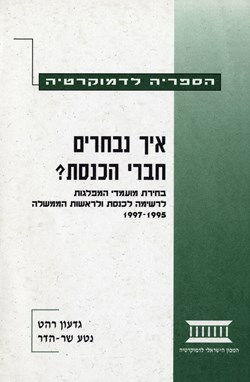Intraparty Selection of Candidates for the Knesset List and for Prime-Ministerial Candidacy, 1995-1997
- Written By: Prof. Gideon Rahat, Neta Sher-Hadar
- Publication Date:
- Cover Type: Softcover | Hebrew
- Number Of Pages: 267 Pages
- Price: 75 NIS
This book on how Knesset members are selected analyzes the system of choosing candidates, the method of competing for places on the Knesset list, personal election campaigns, and the outcome of the competition.
This book on how Knesset members are selected analyzes the system of choosing candidates, the method of competing for places on the Knesset list, personal election campaigns, and the outcome of the competition. This book touches on the choosing of candidates by the majority of parties whose representatives were elected to the Knesset. A recommendation appears at the end of the book concerning how it might be possible to implement more appropriately the idea of public participation in choosing representatives to the Knesset.
When an Israeli citizen arrives at the polling booth to exercise his right to vote for the Knesset, he votes with a slip of paper on which are printed the letters that stand for the party or parties that make up one Knesset list. The 120 Knesset seats are apportioned to the various parties in accordance with the ballot count. But how is the determination made concerning who fills these seats?
That question is the subject of this book, which analyzes the system of choosing candidates, the method of competing for places on the Knesset list, personal election campaigns and the outcome of the competition. During the period from 1995 to 1997, the parties in Israel used a variety of electoral systems in choosing candidates for their Knesset lists, from appointment by a single person to election by more than 100,000 party members.
This book touches on the choosing of candidates by the majority of parties whose representatives were elected to the Knesset, with special emphasis on the primary system that was used in 1996 by three parties: two large ones - Labor and Likud - and the parties comprising Meretz. A separate chapter is devoted to analysis of the primaries for prime minister held by Labor in 1997. Special chapters are also dedicated to examination of primary publicity, adherence to party regulations and by-laws, and critical analysis of the parties' primary systems, as espoused in Israel. A recommendation appears at the end of the book concerning how it might be possible to implement more appropriately the idea of public participation in choosing representatives to the Knesset.

